The costs of managing the disease may be higher than you think.
Clubroot is top of mind for many growers these days, as the disease has recently been discovered in new areas including High Prairie, the Peace River Region of Alberta, and northwest of North Battleford. Prior to these discoveries, clubroot was mostly concentrated in north-central Alberta and parts of Manitoba. The footprint has steadily been spreading through the canola growing regions of Western Canada.

There is currently no control measure that can remove the pathogen from a field once it becomes infected. A clubroot infestation will lead to higher operating costs on your farm.
What are the top costs of clubroot that you may not know about?
- Yield Loss – This is the most obvious cost and also the most devastating. The disease can lead to significant yield losses, 100% if left unchecked. There is currently no chemical treatment to remove or control clubroot in an infested field.
- Sanitation – This is another large cost, both in terms of time and money. Sanitation of equipment is recommended when clubroot is found in a field, to help prevent clubroot from spreading. This can include a rough clean by hand, spraying down and even disinfection of all equipment that moves between fields. Click here to read more from the Canola Council
- Restricted Rotation – You’ll need to lengthen your canola rotation. The Canola Council of Canada recommends growing canola once every four years on infested fields.
- Management Restrictions – All steps should be taken to control clubroot and prevent it from spreading to other parts of your farm. Think of the many items that may have infested soil attached: non-ag machinery, soil on your boots, animals tracking soil from field to field, earth tags on seed and hay bales grown on infested soil. In addition, you’ll need to consider your tillage practices – soil erosion by wind and water can spread the pathogen.
A strategy that is promoted by both the Canola Council of Canada and provincial authorities is to grow clubroot resistant varieties on non-infected land to prevent the disease from gaining a foothold in the field. As the CCC states:
“The risk of using a CR too early and contributing to breaking of the resistance is small compared to the risk from not using a CR variety early and having the disease escalate quickly to very costly levels.”
Learn more about CS2000, a top-performing canola hybrid with the best clubroot resistance available.
Clubroot isn’t a death sentence for your farm, but it can be a very costly disease. An ounce of prevention really is worth a pound of cure when it comes to controlling the spread of clubroot.


